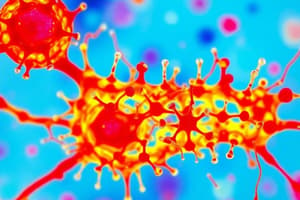Podcast
Questions and Answers
What are the end products of lysine and ornithine when they are acted upon by decarboxylases?
What are the end products of lysine and ornithine when they are acted upon by decarboxylases?
- Histamine and dopamine
- Cadaverine and putrescine (correct)
- Tyrosine and phenylalanine
- Cocaine and serotonin
What type of group do decarboxylases remove from amino acids?
What type of group do decarboxylases remove from amino acids?
- Amino group
- Carboxyl group (correct)
- Hydroxyl group
- Methyl group
Which of the following statements is true about the function of decarboxylases?
Which of the following statements is true about the function of decarboxylases?
- They synthesize carboxyl groups.
- They convert amines into amino acids.
- They convert amino acids into amines. (correct)
- They catalyze the formation of dipeptides.
Which amino acid is specifically converted to putrescine?
Which amino acid is specifically converted to putrescine?
What is the main role of decarboxylases in the conversion of amino acids?
What is the main role of decarboxylases in the conversion of amino acids?
What is the size of Treponema pallidum?
What is the size of Treponema pallidum?
What technique is specifically beneficial for monitoring living organisms?
What technique is specifically beneficial for monitoring living organisms?
What limitation does bright field microscopy have when observing certain organisms?
What limitation does bright field microscopy have when observing certain organisms?
What aspect does dark field microscopy excel in compared to other microscopy techniques?
What aspect does dark field microscopy excel in compared to other microscopy techniques?
Which of the following observations is NOT possible using dark field microscopy?
Which of the following observations is NOT possible using dark field microscopy?
What is the primary advantage of DIC microscopy over bright-field techniques?
What is the primary advantage of DIC microscopy over bright-field techniques?
Which type of cells is DIC microscopy particularly useful for observing?
Which type of cells is DIC microscopy particularly useful for observing?
How does DIC microscopy enhance the observation of internal cell structures?
How does DIC microscopy enhance the observation of internal cell structures?
What might be a limitation of bright-field techniques compared to DIC microscopy?
What might be a limitation of bright-field techniques compared to DIC microscopy?
In what way does DIC microscopy contribute to cellular imaging?
In what way does DIC microscopy contribute to cellular imaging?
What is the main purpose of using negative staining in microbiology?
What is the main purpose of using negative staining in microbiology?
Which of the following stains is commonly used in the negative staining process?
Which of the following stains is commonly used in the negative staining process?
What is the effect of impregnating silver salts on bacterial cells?
What is the effect of impregnating silver salts on bacterial cells?
What is the background color typically used in negative staining?
What is the background color typically used in negative staining?
Which characteristic of certain bacterial capsules is highlighted by negative staining?
Which characteristic of certain bacterial capsules is highlighted by negative staining?
What are chromatic granules associated with?
What are chromatic granules associated with?
What do single enzyme tests commonly determine?
What do single enzyme tests commonly determine?
Which of the following is NOT a component tested in biochemical tests?
Which of the following is NOT a component tested in biochemical tests?
Which statement about chromatic granules is accurate?
Which statement about chromatic granules is accurate?
In the context of bacterial tests, what is meant by 'single enzyme tests'?
In the context of bacterial tests, what is meant by 'single enzyme tests'?
Study Notes
Decarboxylases
- Decarboxylases remove the carboxyl group from amino acids.
- This process converts amino acids into amines.
- Lysine is converted into cadaverine.
- Ornithine is converted into putrescine.
Differential Interference Contrast (DIC) Microscopy
- Useful for observing unstained cells.
- Generates images that reveal internal cell structures.
- DIC microscopy is more effective than bright-field techniques for observing internal cell structures.
Negative Staining
- The background is stained black, highlighting unstained bacterial capsules.
- A drop of bacterial suspension is mixed with dyes like India ink or nigrosin.
- Useful for visualizing bacterial or fungal capsules that do not readily absorb stains.
- Unstained capsules appear prominent and contrasting.
Impregnation Methods
- Enhance visibility of bacterial cells and thin structures, like chromatic granules.
- Employs silver salts on the surface to thicken structures.
- This method makes structures like chromatic granules visible under a light microscope.
Single Enzyme Tests (Biochemical Tests)
- Several tests are commonly used to identify the presence of a single enzyme.
- These tests involve measuring enzyme activity.
Studying That Suits You
Use AI to generate personalized quizzes and flashcards to suit your learning preferences.
Related Documents
Description
This quiz covers key microbiological techniques including decarboxylases in amino acid conversion, differential interference contrast microscopy, negative staining for bacterial capsules, and impregnation methods to enhance visibility of cell structures. Test your knowledge on these important microbiology concepts.




